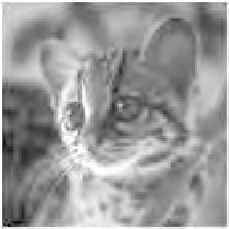Cryptography Reference
In-Depth Information
FIGURE 4.16
Input images. From left to right, original shadow 1, shadow 2, and secret
images, respectively.
4.5.2 Results
Figure 4.16 shows the three input images. Each image corresponds to the
shadow 1, shadow 2, and secret image, respectively, from left to right.
Figure
4.17
gives the encrypted shadow 2 (above) and the secret image reconstructed
by superimposing the output shadows (below). They are generated with 1515
physical subpixels per pixel. For comparison, the shadow 2 (above) and re-
constructed secret images (below) generated with the straightforward density
pattern are depicted in
Figure 4.18.
The images in Figure 4.18 contain 3 3
subpixels per pixel, a practical number of subpixels considering the superim-
position by human hands.
The method is possible to generate quite pleasant results of high image
quality, especially with smoother shading of the petals and the background
stems, or the whiskers and stripes of the cat. This is because the method can
express at least 226 = (1515 + 1) gray levels, which means that the resulting
images can almost fully express the gray levels of the input images. Moreover,
the encrypted shadow images can be superimposed by human hands with little
diculty, as they allow more misalignment tolerance.
4.6 Conclusions
This chapter explained extended visual cryptography handling photograph
images. First, we overlooked the three basic visual cryptography schemes for
binary images, namely, the Visual Secret Sharing Scheme, the Extended Vi-
sual Cryptography Scheme, and Random Grids. Some fundamental concepts
for incorporating photographs into visual cryptography, such as halftoning
techniques, some parameters related to image quality, and issues for handling












Search WWH ::

Custom Search